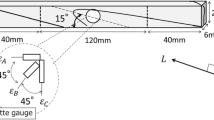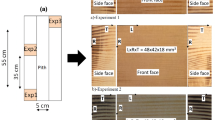Abstract
Microstructural properties of wood vary considerably within a tree. Knowledge of these properties and a better understanding of their relationship to the macroscopic mechanical performance of wood are crucial to optimize the yield and economic value of forest stocks. This holds particularly for the end-use requirements in engineering applications. In this study the microstructure–stiffness relationships of Scots pine are examined with a focus on the effects of the microstructural variability on the elastic properties of wood at different length scales. For this purpose, we have augmented microstructural data acquired using SilviScan-3™ (namely wood density, cell dimensions, earlywood and latewood proportion, microfibril angle) with local measurements of these quantities and of the chemical composition derived from wide-angle X-ray scattering, light microscopy, and thermogravimetric analysis, respectively. The stiffness properties were determined by means of ultrasonic tests at the clear wood scale and by means of nanoindentation at the cell wall scale. In addition, micro-mechanical modeling was applied to assess the causal relations between structural and mechanical properties and to complement the experimental investigations. Typical variability profiles of microstructural and mechanical properties are shown from pith to bark, across a single growth ring and from earlywood to latewood. The clear increase of the longitudinal stiffness as well as the rather constant transverse stiffness from pith to bark could be explained by the variation in microfibril angle and wood density over the entire radial distance. The dependence of local cell wall stiffness on the local microfibril angle was also demonstrated. However, the local properties did not necessarily follow the trends observed at the macroscopic scale and exhibited only a weak relationship with the macroscopic mechanical properties. While the relationship between silvicultural practice and wood microstructure remains to be modeled using statistical techniques, the influence of microstructural properties on the macroscopic mechanical behavior of wood can now be described by a physical model. The knowledge gained by these investigations and the availability of a new micromechanical model, which allows transferring these findings to non-tested material, will be valuable for wood quality assessment and optimization in timber engineering.








Similar content being viewed by others
References
Alteyrac J, Cloutier A, Ung C-H, Zhang SY (2006) Mechanical properties in relation to selected wood characteristics of black spruce. Wood Fiber Sci 38(2):229–237
Auty D (2011) Modelling the effects of forest management on the wood properties and branch characteristics of UK-grown Scots pine. PhD Thesis, University of Aberdeen
Auty D, Gardiner BA, Achim A, Moore JR, Cameron AD (2012) Models for predicting microfibril angle variation in Scots pine. Ann For Sci. doi:10.007/s13595-012-0248-6
Bader TK, Hofstetter K, Hellmich C, Eberhardsteiner J (2011) The poroelastic role of water in cell walls of the hierarchical composite ‘softwood’. Acta Mech 217:75–100
Bader TK, Hofstetter K, Eberhardsteiner J, Keunecke D (2012) Microstructure-stiffness relationships of Common yew and Norway spruce. Strain 48(4):306–316
Bucur V (2006) Acoustics of wood, 2nd edn. Springer, Berlin
Cave ID (1966) Theory of X-ray measurement of microfibril angles in wood. Forest Prod J 16(10):37–43
Cave ID, Walker JCF (1994) Stiffness of wood in fast-grown plantation softwoods: the influence of microfibril angle. Wood Sci Technol 31:225–234
Eder M, Jungnikl K, Burgert I (2009) A close-up view of wood structure and properties across a growth ring of Norway spruce (Picea abies [L] Karst.). Trees Struct Funct 23:79–84
Eriksson D, Lindberg H, Bergsten U (2006) Influence of silvicultural regime on wood structure characteristics and mechanical properties of clear wood in Pinus sylvestris. Silva Fenn 40:743–762
Evans R (1999) A variance approach to the X-ray diffractometric estimation of microfibril angle in wood. Appita J 52:283–294
Evans R (2006) Wood stiffness by X-ray diffractometry. In: Stokke DD, Groom LH (eds) Characterization of the cellulosic cell wall. Blackwell Publishing, Ames, pp 138–146
Fengel D, Wegener G (2003) Wood—chemistry, ultrastructure, reactions. Kessel, Remagen
Grønli MG, Varhegyi G, Di Blasi C (2001) Thermogravimetric analysis and devolatilization kinetics of wood. Ind Eng Chem Res 41(17):4201–4208
Hofstetter K, Hellmich C, Eberhardsteiner J (2005) Development and experimental validation of a continuum micromechanics model for the elasticity of wood. Eur J Mech A Solids 24:1030–1053
Hofstetter K, Hellmich C, Eberhardsteiner J (2007) Micromechanical modeling of solid-type and plate-type deformation patterns within softwood materials: a review and an improved approach. Holzforschung 61:343–351
Jäger A, Bader TK, Hofstetter K, Eberhardsteiner J (2011) The relation between indentation modulus, microfibril angle and elastic properties of wood cell walls. Compos Part A Appl S 42:677–685
Jakes JE, Frihard CR, Beecher JF, Moon RJ, Resto PJ, Melgarejo ZH, Suarez OM, Baumgart H, Elmustafa AA, Stone DS (2009) Nanoindentation near the edge. J Mater Res 24(3):1016–1031
Kohlhauser C, Hellmich C, Vitale-Brovarone C, Rota A, Eberhardsteiner J (2009) Ultrasonic characterization of porous biomaterials across different frequencies. Strain 45:34–44
Kollmann F (1982) Technologie des Holzes und der Holzwerkstoffe (Technology of wood and wood products), vol 1, 2nd edn. Springer, Berlin (in German)
Konnerth J, Harper D, Lee SH, Rials TG, Gindl W (2008) Adhesive penetration of wood cell walls investigated by scanning thermal microscopy (SThM). Holzforschung 62:91–98
Konnerth J, Gierlinger N, Keckes J, Gindl W (2009) Actual versus apparent within cell wall variability of nanoindentation results from wood cell walls related to cellulose microfibril angle. J Mater Sci 44:4399–4406
Koponen T, Karppinen T, Hæggström E, Saranpää P, Serimaa R (2005) The stiffness modulus in Norway spruce as a function of year ring. Holzforschung 59:451–455
MacDonald E, Hubert J (2002) A review of the effects of silviculture on timber quality of Sitka spruce. Forestry 75:107–138
Mäkinen H, Mäkelä A, Hynynen J (2009) Predicting wood and branch properties of Norway spruce as a part of a stand growth simulation system. USDA Forest Service, pp 15–21. General Technical Report PNW-GTR 791
Meylan BA (1967) Measurement of microfibril angle by X-ray diffraction. For Prod J 17(5):51–58
Moore JR, Lyon AJ, Searles GJ, Vihermaa LE (2009) The effects of site and stand factors on the tree and wood quality of Sitka spruce growing in the United Kingdom. Silva Fenn 43:383–396
Oliver WC, Pharr GM (1992) An improved technique for determining hardness and elastic modulus using load and displacement sensing indentation experiments. J Mater Res 7:1564–1583
Sedighi-Gilani M, Sunderland H, Navi P (2005) Microfibril angle non-uniformities within normal and compression wood tracheids. Wood Sci Technol 29:419–430
Senft JF, Bendtsen BA (1985) Measuring microfibrillar angles using light microscopy. Wood Fib Sci 17(4):564–567
Suquet P (1987) Elements of homogenization for inelastic solid mechanics. In: Sanchez-Palencia E, Zaoui A (eds) Homogenization techniques for composite media. Springer, Wien, pp 109–143
Vihermaa LE (2010) Influence of site factors and climate on timber properties of Sitka spruce. PhD Thesis, University of Glasgow
Wimmer R, Lucas BN (1997) Comparing mechanical properties of secondary wall and cell corner middle lamella in spruce wood. IAWA J 18(1):77–88
Zaoui A (2002) Continuum micromechanics: survey. J Eng Mech ASCE 128:808–816
Zhang B, Fei B, Yu Y, Zhao R (2007) Microfibril angle variability in Masson pine (Pinus massoniana Lamb.) using X-ray diffraction. For Stud China 9(1):33–38
Acknowledgments
The authors would like to acknowledge Prof. Herwig Peterlik (University of Vienna) and Dr Thomas Koch (Vienna University of Technology) for providing the equipment for the WAXS and TGA measurements, respectively. The SilviScan-3™ work was undertaken as part of the David Auty’s PhD thesis, which was jointly funded by Corporate and Forestry Services, Forestry Commission, UK, and the Scottish Forestry Trust. Additional funding was provided by the European Cooperation in Science and Technology (COST) program, under the Short Term Scientific Mission initiative under COST Actions E50 and FP0802.
Author information
Authors and Affiliations
Corresponding author
Additional information
Communicated by M. Adams.
Rights and permissions
About this article
Cite this article
Wagner, L., Bader, T.K., Auty, D. et al. Key parameters controlling stiffness variability within trees: a multiscale experimental–numerical approach. Trees 27, 321–336 (2013). https://doi.org/10.1007/s00468-012-0801-9
Received:
Revised:
Accepted:
Published:
Issue Date:
DOI: https://doi.org/10.1007/s00468-012-0801-9




